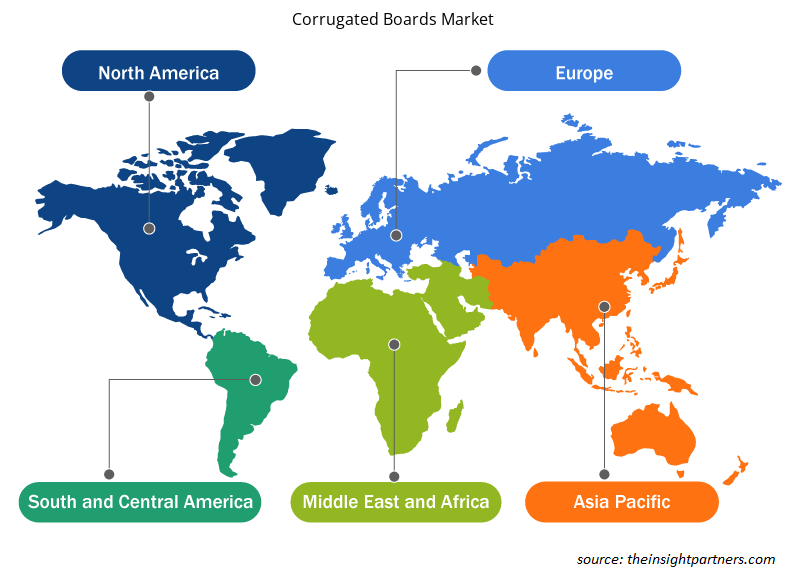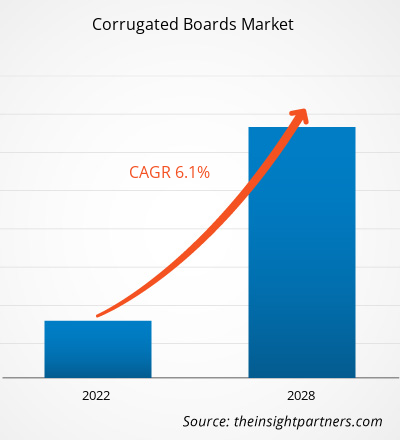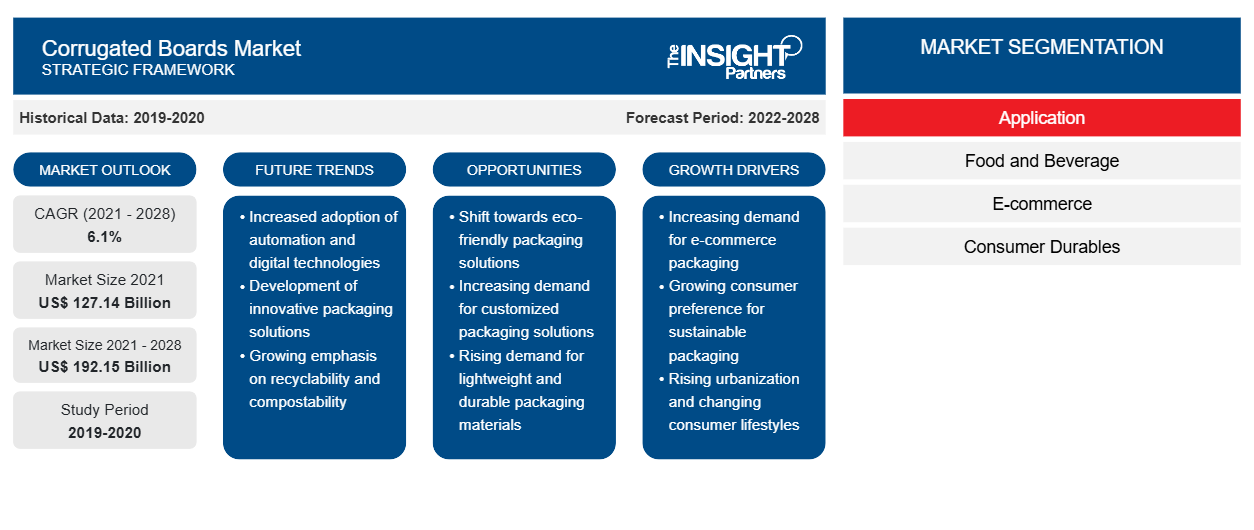[Forschungsbericht] Der Markt für Wellpappe wurde im Jahr 2021 auf 127.139,07 Millionen US-Dollar geschätzt und soll bis 2028 192.153,31 Millionen US-Dollar erreichen; von 2021 bis 2028 wird ein durchschnittliches jährliches Wachstum von 6,1 % erwartet.
Bei Wellpappeverpackungen handelt es sich um die Verpackung verschiedener Waren, wie z. B. Lebensmittel und Getränke, langlebige Konsumgüter sowie elektronische und elektrische Geräte, in Wellpappkartons für den Weitertransport. Die Verwendung von Wellpappe für Verpackungen ist eine kostengünstige und anpassungsfähige Verpackungstechnik zum Schutz, zur Konservierung und zum Transport einer Vielzahl von Artikeln. Wellpappe eignet sich für die Anwendung in einer Vielzahl von Branchen, wie z. B. Lebensmittel und Getränke, langlebige Konsumgüter, Elektro- und Elektronikartikel, Papier, Chemikalien, Körperpflege- und Haushaltsprodukte, Landwirtschaft, Forstwirtschaft, Fischerei sowie Kunststoff- und Gummiprodukte.
Im Jahr 2020 hatte der asiatisch-pazifische Raum den größten Anteil am weltweiten Wellpappenmarkt und wird im Prognosezeitraum voraussichtlich die höchste durchschnittliche jährliche Wachstumsrate (CAGR) auf dem Markt verzeichnen. Im asiatisch-pazifischen Raum ist der Verbrauch von Wellpappe in verschiedenen Branchen wie Lebensmittel und Getränke, Elektronik und E-Commerce gestiegen. Das gestiegene Bewusstsein für nachhaltige und kostengünstige Verpackungslösungen aus Wellpappe, die beim Transport von Produkten verwendet werden, und verschiedene Initiativen der Regierung zum Verbot von Kunststoffverpackungen in mehreren asiatischen Ländern werden die Nachfrage nach Wellpappe in der Region in den kommenden Jahren steigern. Darüber hinaus treibt ein gestiegenes Umweltbewusstsein die Nachfrage nach umweltfreundlicheren Verpackungslösungen an, was das Wachstum des Wellpappenmarktes vorantreibt. Darüber hinaus treibt die steigende Nachfrage nach Elektronikartikeln, Autoteilen, Haushaltspflege- sowie Schönheits- und Körperpflegeprodukten auf inländischen und internationalen Märkten die Nachfrage nach Wellpappkartons an und treibt damit das Wachstum des Wellpappenmarktes voran. Die E-Commerce-Branche wächst in der Region rasant. Amazon, einer der größten E-Commerce-Händler, verwendet hauptsächlich Wellpappe als Verpackung und setzt bei Einzelartikeln im asiatisch-pazifischen Raum auf Kunststoffverpackungen. In Thailand dürfte die zunehmende Besorgnis über Verpackungsabfälle die Regierung dazu zwingen, Vorschriften zu erlassen, die die Bürger dazu veranlassen, umweltfreundliche Optionen wie Faltschachteln oder Wellpappe als praktikable Verpackungsalternative zu wählen, was dem Wellpappenmarkt in der Region im Prognosezeitraum Wachstumschancen bieten würde.
Passen Sie diesen Bericht Ihren Anforderungen an
Sie erhalten kostenlos individuelle Anpassungen an jedem Bericht, einschließlich Teilen dieses Berichts oder einer Analyse auf Länderebene, eines Excel-Datenpakets sowie tolle Angebote und Rabatte für Start-ups und Universitäten.
- Holen Sie sich die wichtigsten Markttrends aus diesem Bericht.Dieses KOSTENLOSE Beispiel umfasst eine Datenanalyse von Markttrends bis hin zu Schätzungen und Prognosen.
Auswirkungen der COVID-19-Pandemie auf den Wellpappenmarkt
Viele Branchen, wie etwa die Chemie- und Materialindustrie, standen aufgrund der COVID-19-Pandemie vor beispiellosen Herausforderungen. Die Umsetzung der COVID-19-Sicherheitsprotokolle führte zu Rohstoff- und Arbeitskräftemangel, Fabrikschließungen und anderen betrieblichen Schwierigkeiten. Daher mussten Unternehmen, die Verpackungsprodukte herstellen, in den ersten Monaten der Pandemie einen Umsatzrückgang hinnehmen. Der E-Commerce-Sektor verzeichnete aufgrund der Schließung von Offline-Geschäften eine erhebliche Nachfrage nach verschiedenen Produkten wie verpackten Lebensmitteln und Getränken, Lebensmitteln, Alltagsgegenständen und langlebigen Konsumgütern. Mit dem schnell wachsenden E-Commerce-Sektor gab es selbst während der COVID-19-Pandemie eine erhebliche Nachfrage aus dem E-Commerce-Sektor nach Wellpappe zum Verpacken und Transportieren verschiedener Waren. Aufgrund des Rohstoffmangels und der Schließung von Produktionseinheiten aufgrund längerer landesweiter Lockdowns gab es jedoch eine enorme Lücke zwischen Angebot und Nachfrage, die sich negativ auf das Wachstum des Wellpappenmarktes auswirkte. Darüber hinaus erlitt die Verpackungsindustrie aufgrund der Verlangsamung der Logistikabläufe erhebliche Verluste.
Die Unternehmen gewinnen an Boden, da die Regierungen verschiedener Länder die zuvor verhängten Beschränkungen gelockert haben. Darüber hinaus hat die Einführung des COVID-19-Impfstoffs die Situation entspannt und zu einem Anstieg der Geschäftsaktivitäten auf der ganzen Welt geführt. Darüber hinaus trieben Logistikunternehmen, die mit dem Transport von Gütern des täglichen Bedarfs sowie Lebensmitteln und Getränken befasst sind, die Nachfrage nach Wellpappe an. Daher wird erwartet, dass der globale Markt für Wellpappe in den kommenden Jahren deutlich wachsen wird. Die COVID-19-Pandemie hat die Entwicklung der E-Commerce-Branche vorangetrieben. Sie hat den Kunden Zugang zu einer breiten Palette von Produkten verschafft, darunter lebensnotwendige Güter, Convenience-Produkte und Sicherheitsgüter. Sie hat es den Unternehmen auch ermöglicht, trotz der Einschränkungen und Beschränkungen, die für verschiedene Industrie- und Transportaktivitäten verhängt wurden, weiter zu arbeiten. Die E-Commerce-Branche hat erheblich zur Wiederbelebung der Logistikabläufe beigetragen, was wiederum das Wachstum des Wellpappenmarktes in den kommenden Jahren ankurbeln dürfte.
Markteinblicke
Rasante Expansion des Online-Handels
E-Commerce-Plattformen haben weltweit erheblich an Dynamik gewonnen, da Unternehmen zunehmend in die Ausweitung ihrer geografischen Reichweite über verschiedene Vertriebskanäle investieren und der Industriesektor wächst. Infolgedessen ist die Zahl der Direktlieferungen an Verbraucher im Vergleich zur Standardverteilung um das 20-fache oder mehr gestiegen. Darüber hinaus haben Online-Händler in den letzten Jahren aufgrund technologischer Innovationen ein erhebliches Wachstum erlebt, was die Nachfrage nach Wellpappenverpackungsprodukten angekurbelt hat. Die COVID-19-Pandemie hat das Wachstum des Online-Einzelhandels aufgrund der vorgeschriebenen sozialen Distanzierung an öffentlichen Orten und der erlassenen Beschränkungen für den persönlichen Handel verschlimmert. Laut einem im März 2021 in The Rio Times veröffentlichten Artikel stiegen die über E-Commerce-Vertriebskanäle erzielten Umsätze im Jahr 2020 um 41 %, wobei brasilianische Verbraucher im Jahr mehr als 194 Millionen Bestellungen aufgaben. Dies gilt als der höchste prozentuale Anstieg, der in Brasilien seit 2007 verzeichnet wurde. Laut Eurostat waren im Jahr 2020 70 % der europäischen Bevölkerung Online-Käufer, im Jahr 2016 waren es noch 60 %. Daher treibt das Wachstum der E-Commerce-Branche die Nachfrage nach fortschrittlichen Verpackungslösungen wie Wellpappe weltweit an.
Anwendungseinblicke
Basierend auf der Anwendung ist der Markt für Wellpappe in Lebensmittel und Getränke, E-Commerce, langlebige Konsumgüter, Elektro- und Elektronikartikel und andere unterteilt. Das Segment Lebensmittel und Getränke hatte im Jahr 2020 den größten Marktanteil, während das Segment E-Commerce im Prognosezeitraum voraussichtlich die höchste durchschnittliche jährliche Wachstumsrate auf dem Markt verzeichnen wird. In der Lebensmittel- und Getränkeindustrie wird Wellpappe häufig für die Verpackung und den Transport verschiedener Lebensmittelprodukte verwendet. Sie wird zur Herstellung von Kartons und Schachteln verwendet, die beim Transport und der Handhabung verschiedener Artikel wie frischem Obst und Gemüse, Fleischprodukten, Eiern und Backwaren eine feste Polsterung bieten, und sie ist eine der sichersten und hygienischsten Verpackungsoptionen auf dem Markt. Wellpappe ist sauber und hygienisch, da sie bei hohen Temperaturen hergestellt wird. Die Platten halten optimale Feuchtigkeitsniveaus aufrecht und verhindern das Wachstum von Bakterien, was sie ideal für den Versand verderblicher Lebensmittel macht. Dieser Faktor dürfte die Nachfrage nach Wellpappe aus der Lebensmittel- und Getränkeverpackungsindustrie in den kommenden Jahren ankurbeln.
Einige auf dem Wellpappenmarkt tätige Akteure sind IRANI PAPEL E EMBALAGEM SA; Schlumpfit Kappa; Klabin SA; WestRock Company; Internationales Papier; Arcor; Klingele Papierwerke GmbH & Co. KG; Papeles y Conversiones de México; Mondi; und NIPPON PAPER INDUSTRIES CO., LTD.
Regionale Einblicke in den Wellpappenmarkt
Die regionalen Trends und Faktoren, die den Wellpappenmarkt im Prognosezeitraum beeinflussen, wurden von den Analysten von Insight Partners ausführlich erläutert. In diesem Abschnitt werden auch die Marktsegmente und die Geografie von Wellpappen in Nordamerika, Europa, im asiatisch-pazifischen Raum, im Nahen Osten und Afrika sowie in Süd- und Mittelamerika erörtert.

- Erhalten Sie regionale Daten zum Wellpappenmarkt
Umfang des Marktberichts über Wellpappe
| Berichtsattribut | Details |
|---|---|
| Marktgröße im Jahr 2021 | 127,14 Milliarden US-Dollar |
| Marktgröße bis 2028 | 192,15 Milliarden US-Dollar |
| Globale CAGR (2021 - 2028) | 6,1 % |
| Historische Daten | 2019-2020 |
| Prognosezeitraum | 2022–2028 |
| Abgedeckte Segmente | Nach Anwendung
|
| Abgedeckte Regionen und Länder | Nordamerika
|
| Marktführer und wichtige Unternehmensprofile |
|
Dichte der Marktteilnehmer für Wellpappe: Auswirkungen auf die Geschäftsdynamik verstehen
Der Markt für Wellpappe wächst rasant, angetrieben durch die steigende Nachfrage der Endverbraucher aufgrund von Faktoren wie sich entwickelnden Verbraucherpräferenzen, technologischen Fortschritten und einem größeren Bewusstsein für die Vorteile des Produkts. Mit steigender Nachfrage erweitern Unternehmen ihr Angebot, entwickeln Innovationen, um die Bedürfnisse der Verbraucher zu erfüllen, und nutzen neue Trends, was das Marktwachstum weiter ankurbelt.
Die Marktteilnehmerdichte bezieht sich auf die Verteilung der Firmen oder Unternehmen, die in einem bestimmten Markt oder einer bestimmten Branche tätig sind. Sie gibt an, wie viele Wettbewerber (Marktteilnehmer) in einem bestimmten Marktraum im Verhältnis zu seiner Größe oder seinem gesamten Marktwert präsent sind.
Die wichtigsten auf dem Wellpappenmarkt tätigen Unternehmen sind:
- IRANI PAPEL E EMBALAGEM SA
- Smurfit Kappa
- Klabin SA
- WestRock Company
- Internationales Papier
Haftungsausschluss : Die oben aufgeführten Unternehmen sind nicht in einer bestimmten Reihenfolge aufgeführt.

- Überblick über die wichtigsten Akteure auf dem Wellpappenmarkt
Bericht-Spotlights
- Fortschrittliche Branchentrends im Wellpappenmarkt helfen den Akteuren bei der Entwicklung wirksamer langfristiger Strategien
- In Industrie- und Entwicklungsländern angewandte Strategien für Unternehmenswachstum
- Quantitative Analyse des Wellpappenmarktes von 2019 bis 2028
- Schätzung der weltweiten Nachfrage nach Wellpappe
- Porters Fünf-Kräfte-Analyse zur Veranschaulichung der Wirksamkeit von Käufern und Lieferanten in der Branche
- Aktuelle Entwicklungen zum Verständnis des wettbewerbsorientierten Marktszenarios
- Markttrends und -aussichten sowie Faktoren, die das Wachstum des Wellpappenmarktes vorantreiben und bremsen
- Unterstützung im Entscheidungsprozess durch Aufzeigen von Marktstrategien, die das kommerzielle Interesse untermauern und zum Marktwachstum führen
- Die Größe des Wellpappenmarktes an verschiedenen Knotenpunkten
- Detaillierte Übersicht und Segmentierung des Marktes sowie der Dynamik der Wellpappenindustrie
- Größe des Wellpappenmarktes in verschiedenen Regionen mit vielversprechenden Wachstumschancen
Wellpappenmarkt – nach Anwendung
- Nahrungsmittel und Getränke
- Elektronischer Handel
- Gebrauchsgüter
- Elektrik und Elektronik
- Sonstiges
Firmenprofile
- IRANI PAPEL E EMBALAGEM SA
- Smurfit Kappa
- Klabin SA
- WestRock Company
- Internationales Papier
- Arcor
- Klingele Papierwerke GmbH & Co. KG
- Papeles y Conversiones de México
- Mondi
- NIPPON PAPER INDUSTRIES CO., LTD.
- Historische Analyse (2 Jahre), Basisjahr, Prognose (7 Jahre) mit CAGR
- PEST- und SWOT-Analyse
- Marktgröße Wert/Volumen – Global, Regional, Land
- Branchen- und Wettbewerbslandschaft
- Excel-Datensatz
Aktuelle Berichte
Erfahrungsberichte
Grund zum Kauf
- Fundierte Entscheidungsfindung
- Marktdynamik verstehen
- Wettbewerbsanalyse
- Kundeneinblicke
- Marktprognosen
- Risikominimierung
- Strategische Planung
- Investitionsbegründung
- Identifizierung neuer Märkte
- Verbesserung von Marketingstrategien
- Steigerung der Betriebseffizienz
- Anpassung an regulatorische Trends





















 Kostenlose Probe anfordern für - Markt für Wellpappe
Kostenlose Probe anfordern für - Markt für Wellpappe